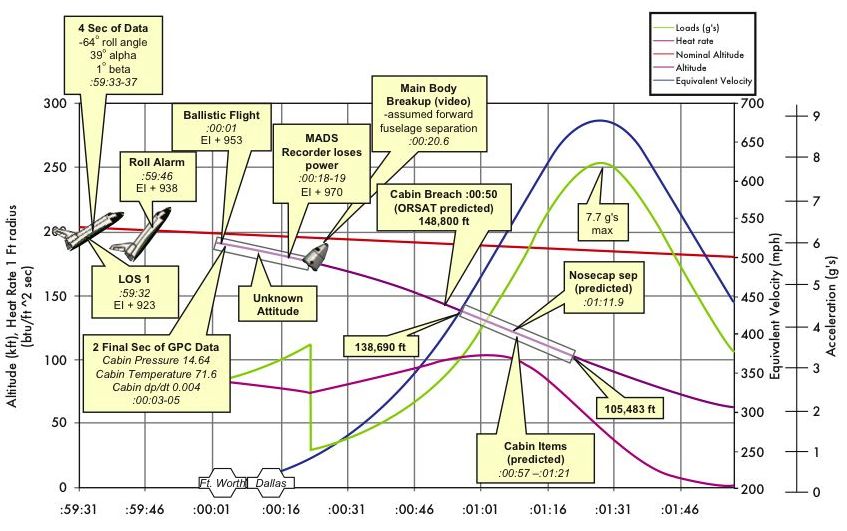STS-107 CREW SURVIVABILITY
STS-107 CREW SURVIVABILITY
At the Boards request, NASA formed a Crew Survivability Working Group within two weeks of the accident to better understand the cause of crew death and the breakup of the crew module. This group made the following observations.
事故調査委員会の要請に従い、クルーの死因と乗務員モジュールの分解についての理解を深める目的で、乗員生存率に関するワーキンググループが事故の2週間以内に組織されました。本グループは以下の調査を行いました。
Medical and Life Sciences
医学・生物学領域
The Working Group found no irregularities in its extensive review of all applicable medical records and crew health data. The Armed Forces Institute of Pathology and the Federal Bureau of Investigation conducted forensic analyses on the remains of the crew of Columbia after they were recovered. It was determined that the acceleration levels the crew module experienced prior to its catastrophic failure were not lethal. The death of the crew members was due to blunt trauma and hypoxia. The exact time of death ュ sometime after 9:00:19 a.m. Eastern Standard Time ュ cannot be determined because of the lack of direct physical or recorded evidence.
ワーキンググループは乗務員の当該期間のカルテと健康データのレビューを行いましたが、なんら異常はありませんでした。また、軍病理学研究所と連邦捜査局は収容されたコロンビアの乗組員の遺体の法医学的な分析を行いました。最終的な崩壊以前に乗務員モジュールがさらされた加速度は致命的なレベルではありませんでした。乗務員の死因は全身を強く打ったこと(鈍性外傷)および酸欠です。死亡時刻は東部標準時午前9:00:19以降。直接の物理的ないし記録された証拠がないために、正確な時間は特定することができません。
Failure of the Crew Module
乗務員モジュールの分解
The forensic evaluation of all recovered crew module/forward fuselage components did not show any evidence of over-pres- surization or explosion. This conclusion is supported by both the lack of forensic evidence and a credible source for either sort of event.11 The failure of the crew module resulted from the thermal degradation of structural properties, which resulted in a rapid catastrophic sequential structural breakdown rather than an instantaneous "explosive" failure.
回収された乗務員モジュールおよび前部胴体にかんする包囲学的な検証結果は、異常な圧力や爆発がいっさいなかったことを示しています。この結論は検死結果と、これらの現象による損傷などが見られなかったことから得られたものです。乗務員モジュールの分解の原因は熱による構造的な劣化によって起きました。それは、瞬間的な爆発によるも破壊というよりも、むしろ急速に進行する崩壊というべきものでした。
Separation of the crew module/forward fuselage assembly from the rest of the Orbiter likely occurred immediately in front of the payload bay (between Xo576 and Xo582 bulkheads). Subsequent breakup of the assembly was a result of ballistic heating and dynamic loading. Evaluations of fractures on both primary and secondary structure elements suggest that structural failures occurred at high temperatures and in some cases at high strain rates. An extensive trajectory reconstruction established the most likely breakup sequence, shown below.
乗務員モジュール/前部胴体が残りのオービターから分離したのは、ペイロードベイのすぐ前方だったと思われます(Xo576とXo582隔壁の間)。その後、モジュールは空力加熱と動圧の増加によって空中分解しました。1次、2次両方の構造的な要素に関する分析は、構造的な破壊が高温かつ高負荷の状態で起きたことを示唆しています。分析によって再構成されたオービターの軌道によると、崩壊までの過程は以下のとおりです。

The load and heat rate calculations are shown for the crew module along its reconstructed trajectory. The band superimposed on the trajectory (starting about 9:00:58 a.m. EST) represents the window where all the evaluated debris originated. It appears that the destruction of the crew module took place over a period of 24 seconds beginning at an altitude of approximately 140,000 feet and ending at 105,000 feet. These figures are consistent with the results of independent thermal re-entry and aerodynamic models. The debris footprint proved consistent with the results of these trajectory analyses and models. Ap- proximately 40 to 50 percent, by weight, of the crew module was recovered.
乗務員モジュールへの負荷と温度上昇の予測値が、オービターの経路にしたがって示されています。また、経路上に幅が持たせてある部分(東部標準時9:00:58 a.m.から続く部分)、は、回収された破片が由来したと思われる経路上の位置を示しています。乗務員モジュールの破壊は24秒間に渡って続き、高度約140,000フィートの地点から始まり、105,000フィートの地点で終わりました。これらの数値は、それぞれ独立して求められた再突入時の熱と空力のモデルの結果と一致しています。また、破片の回収位置は軌道分析とこれらのモデルが一致していることを示しています。乗務員モジュールの破片は、元の重量の40%から50%分が回収されました。
The Working Groups results significantly add to the knowledge gained from the loss of Challenger in 1986. Such knowledge is critical to efforts to improve crew survivability when designing new vehicles and identifying feasible improvements to the exist- ing Orbiters.
ワーキンググループの出した結論は、1986年のチャレンジャー事故で得られた教訓にさらに新たなものを付け加えます。このような知識は現状のオービターに改良を施し、さらに新しい機体をデザインする際に、乗務員の生存性を向上させる際に非常に重要なものとなるでしょう。
Crew Worn Equipment
乗務員が着用していた機材
Videos of the crew during re-entry that have been made public demonstrate that prescribed procedures for use of equipment such as full-pressure suits, gloves, and helmets were not strictly followed. This is confirmed by the Working Groups conclu- sions that three crew members were not wearing gloves, and one was not wearing a helmet. However, under these circumstances, this did not affect their chances of survival.
公開された再突入時の様子を撮影した映像からは、事前に定められた所定の機材の使用―完全与圧服、手袋、ヘルメットの着用などが守られていなかったことを示しています。3人の乗務員が手袋を着用しておらず、1人はヘルメットを着用していませんでした。しかし、このような状況では、これらの機材の使用の有無は生存の可能性には影響しませんでした。